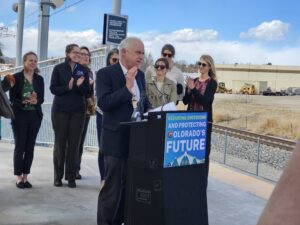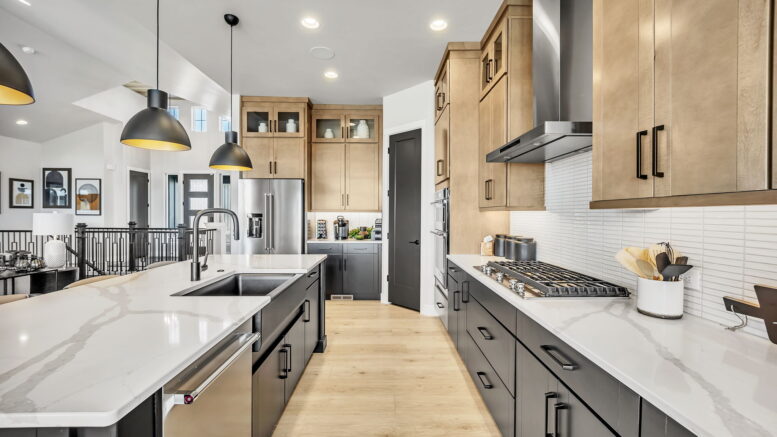Colorado officials approved building codes Friday for new residential and commercial structures that demand more energy efficiency and do so in specific ways that favor a transition from natural gas to electricity, heat pumps and other, greener sources.
Members of the Energy Code Board, which came about after passage of a 2022 law requiring reductions in carbon emissions from new structures, met Tuesday and Friday to consider 89 changes to Colorado’s Low Energy and Carbon Code. Most passed, and after some cleanup, state officials will publish and enact the changes on Sept. 1, requiring the local governments that regulate most construction to adopt them whenever they update their building codes, beginning in July 2026.
The codes set up new requirements for buildings to earn a certain number of credits to achieve minimum Energy Rating Index scores, typically by installing lower energy-efficiency heating and cooling systems and systems that move away from fossil-fuel usage. The number of things that buildings must do to achieve compliance is based on their size — for example, there are three tiers of requirements for new homes under 5,000 square feet, between 5,001 and 7,500 square feet and over 7,500 square feet.
Big debate on building codes’ impact on affordability
Enabling legislation required the Energy Code Board to take housing affordability into consideration when passing the new codes, and that issue created most of the debates as the board neared completion of the codes. A handful of members said a good number of the new requirements would exacerbate the existing affordability crisis, while the majority, including Colorado Energy Office Executive Director Will Toor, said the tiering of regulations by building size offset those concerns.
“I think that it very appropriately helps to define our twin missions of maximizing carbon reduction and, at the same time, having home affordability by focusing the tougher standards for homes that have higher energy use and are unlikely to have an impact on affordability,” Toor said.

Colorado Energy Office Executive Director Will Toor discusses plans to lower greenhouse gas emissions during a 2024 news conference at Westminster Station.
Home builders have warned the new requirements could add $25,000 to $35,000 to the price of larger new homes — residences that are becoming more popular and less opulent because many families are housing multiple generations under one roof to save money. Andrew Harris, a Richmond American Homes of Colorado senior officer and code-board member, warned that what builders must to do to bring larger homes into compliance will lead to major price hikes, and he called parts of the new code “a great disservice.”
“I’m still challenged by what I believe is an inconsistent — or lack of — approach to deal with affordability,” Harris said Friday.
Building codes require reduced on-site energy usage
The effort comes as different parts of the Northern Front Range remain in serious or severe nonattainment of U.S Environmental Protection Agency ozone standards, leading state officials to try a variety of tactics to try to improve air quality. Underlying the more than 80 additions to the recommended state building code are a push to use less energy in heating and lighting buildings, as well as in tasks from refrigeration to cooking.
To achieve compliance with the codes, new homes must earn credits toward the Energy Rating Index. Large amounts of those credits can come from decarbonizing actions like installing heat pumps instead of gas-fueled heating and cooling systems. But they can also come from installation of evaporative cooling equipment or higher-efficiency HVAC equipment, use of low-global-warming-potential space heating and service water heating or extensive duct-leakage testing.
Similarly, commercial buildings can get credits by taking actions like adding high-efficiency heating equipment that serves at least 90% of the total floor area, adding automatic-closing equipment to refrigeration doors and installing evaporative cooling. The new codes require daylight-responsive controls for general lighting in spaces with larger wattage, and the credits required of multifamily residential buildings will be calculated based on the average space of each housing units.
Why home sizes are at the center of arguments

A Classic Homes residence in Colorado Springs
Most controversial among the new changes was the tougher requirements for larger homes — requirements that existing homes can move into as well if they make additions of 1,000 square feet or more. Board members felt some of the proposals were too deleterious to home affordability and rejected them.
The board overwhelmingly killed a proposal to require grade-one insulation — the addition of exterior insulation board to the wall assembly for the purpose of achieving additional energy efficiency — throughout the home, as insulation requirements are dictated by a manufacturer’s installation instructions. It also rejected a requirement to require covering of indoor pools, and it cut back on proposed electric-vehicle infrastructure mandates for parking lots with fewer than 15 spaces.
But efforts to ease other parts of the code were rejected by the board, often after Toor spoke up against them. Board members, for example, refused to offer credits for controlled heat pumps having electric resistance or gas components and refused exemptions on insulation requirements for unheated slabs over sunrooms or heated garages.
“Fuel debiasing”
And the board also refused to add an appendix that would permit local governments to use energy costs as a factor when adopting pathways to comply with the state code rather than just measure the energy used on site of the building when considering its efficiency. While about half the board said this would give builders more options to keeping costs down and meeting carbon-reduction goals, Toor said he did not want to bias any builder away from electrification and toward installation of gas, and the other half of the board agreed.
Speaking in general about the new codes, board member Elizabeth Gillmor, a licensed architectural engineer, said they comprise a collection of strategies aimed at reducing reliance on fossil fuels for heating, cooling and energy needs. In that sense, homebuilders will have to shift their efforts to more use of renewable energy sources, electric power and increased energy efficiency going forward.
“There’s a lot of work and a lot of thought put into these amendments,” Gillmor said. “I think they achieve fuel debiasing … A compliant building today will be a compliant building tomorrow, even if energy costs change.”
